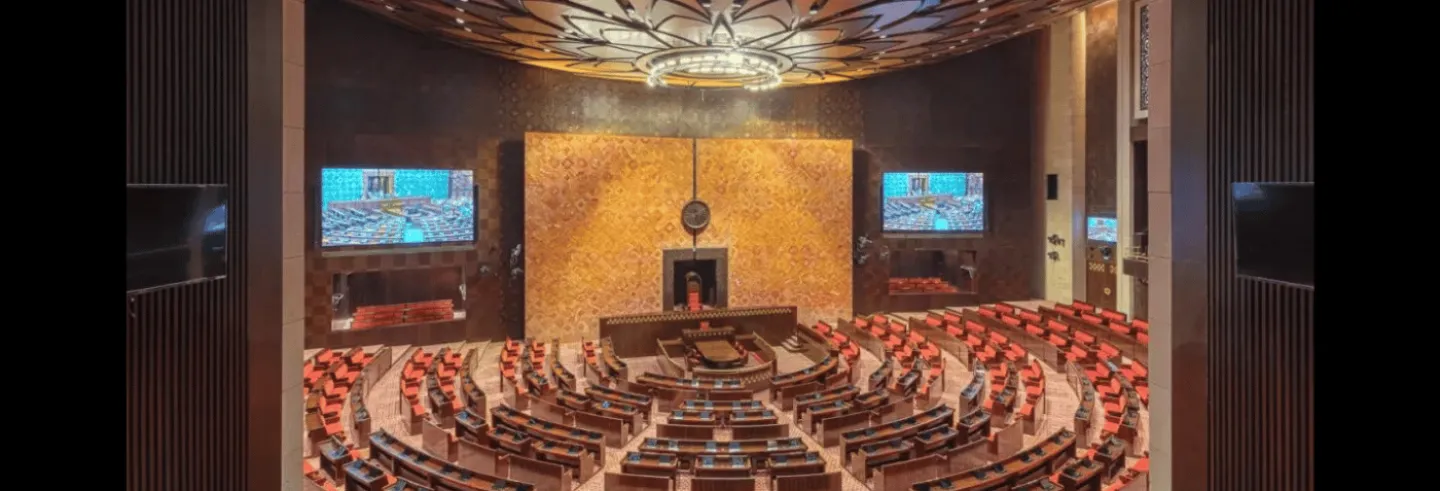A system of representative democracy presupposes some form of election to elect a set of representatives. For this, the first step is partitioning the voting population into spatial units, called electoral constituencies or districts, and the like. An electoral constituency thus combines both land and people to constitute the building block of the system of representative democracy (Singh 2000).
Demarcating a territory and population to form an electoral constituency involves multiple institutions and multi-level processes. The process of carving out electoral constituencies and drawing or redrawing their boundaries is called boundary delimitation. Often, the word delimitation is interchangeably used with words such as redistricting and reapportionment.
The act of drawing up electoral boundaries is important in systems that rely solely on single-seat or small multi-seat constituencies (India, the US, Canada, and so on), with no preference voting scheme to counterbalance any disproportionality of votes to seats (Handley and Grofman 2018). Even so, delimitation of electoral constituencies does not occur as frequently as elections do. In most countries, the period between two rounds of delimitation is longer than that between two elections.
Constituencies are to be carved out in such a manner that (a) the ratio of seats to population will be same for each state and (b) the number of people per constituency will be constant for a state.
How constituency boundaries are fixed has implications for political representation. Therefore, countries enact laws on how constituencies ought to be carved out. In India, the Constitution provides the ground rules for demarcating electoral constituencies. Article 81 of the Constitution provides for how Lok Sabha seats have to be divided into territorial constituencies. According to it, constituencies are to be carved out in such a manner that (a) the ratio of seats to population will be same for each state and (b) the number of people per constituency will be constant for a state.
Article 170 (2) asserts that “each state shall be divided into territorial constituencies in such manner that the ratio between the population of each constituency and the number of seats allotted to it shall, so far as practicable, be the same throughout the state.” These provisions emphasise adhering to population parity while fixing constituency boundaries. This has a number of normative/theoretical and political/practical implications. One of them is periodically reapportioning and/or readjusting electoral boundaries.
Need for periodic revision
With a few exceptions (for example, France), countries have some mandatory interval by which constituency boundaries must be revisited. The need for periodically readjusting electoral boundaries comes from the normative notion of equality of representation, according to which electoral districts ought to be so delimited that they contain an equal number of the voting population. So, one’s vote counts as much as another – no more, no less (Blainski and Young 2001). From this perspective, fair representation is ensured when citizens’ votes across constituencies have equal value. This has come to be known as the doctrine of “one person-one vote-one value.”
Anticipating that spatially uneven patterns of population growth might disturb the principle of population parity, the makers of the Indian Constitution provided for a periodic readjustment of constituency boundaries.
But constituencies are a dynamic entity. Their size of an electorate expands or shrinks due to spatially embedded demographic factors combined with migration from one region/administrative unit to another (for different reasons, such as education or employment). Most typically, this phenomenon is observed in developing countries where demographic and developmental processes remain deeply spatially entrenched.
Even so, there is no standard time interval for revisiting electoral boundaries. While New Zealand redraws electoral boundaries every five years and Australia at least every seven years, the US and Canada do so every 10 years. In the United Kingdom (UK), there is a slightly longer 12 years between delimitations. There also are countries that do not carry out any delimitation within a stipulated time frame mandated by electoral laws.
The Indian case
Historically, India has experienced uneven growth of population across regions and administrative units. Today, different parts of the country are staying at or passing through different stages of demographic transition. Anticipating that spatially uneven patterns of population growth might disturb the principle of population parity, the makers of the Indian Constitution provided for a periodic readjustment of constituency boundaries. According to Articles 82 and 170 (3) of the Constitution, a delimitation should occur every 10 years in sync with a decennial population census.
For the first general election of post-Independence India, constituencies were carved out under the Representation of the People Act (1950), with the ground work being done by the Election Commission of India. As the exercise was found to be fraught with procedural shortcomings, the Election Commission advised the union government to set up an independent commission for future delimitations. Following this, the Delimitation Commission Act, 1952 was enacted.
The first delimitation commission redrew electoral boundaries based on the population figures of the 1951 census. The second delimitation commission was set up in 1962, and it redrew electoral boundaries and redistributed seats on the basis of the 1961 census. The third delimitation commission was constituted in 1972, which prepared a delimitation plan based on the 1971 census. Thus, the first three rounds of delimitation occurred every 10 years as envisaged in the Constitution.
Uninterrupted delimitation of electoral constituencies ensured that the variation in people to representative ratio (PRR) for Lok Sabha seats across states (minus the smaller ones) was insignificant. For example, the ratio as worked out by the third delimitation varied from 10.31 lakh in Rajasthan to 10.67 lakh in Kerala (Table 1). 1The third delimitation commission reallocated seats to different states/union territories. Of the total 543 seats, 36 were allocated to the smaller states/union territories such as Meghalaya, Mizoram, Goa, Andaman and Nicobar, and Lakshadweep. The remaining 507 seats were allocated among the 15 major states as per the population figures of the 1971 census. The 5,293 lakh population of the major states was divided by 507 to determine the population per Lok Sabha seat. The average of 10.44 lakh so obtained was applied to the population of each state so to redistribute seats among them. As in the case of Lok Sabha seats, the ratio for legislative assemblies across states was about the same (Table 2). Thus, previous delimitation exercises broadly met the constitutional requirement of population parity within and across states, and for both Lok Sabha and assembly constituencies.
Table 1: People to Representative Ratio for Lok Sabha in the Third Delimitation (1972–76)
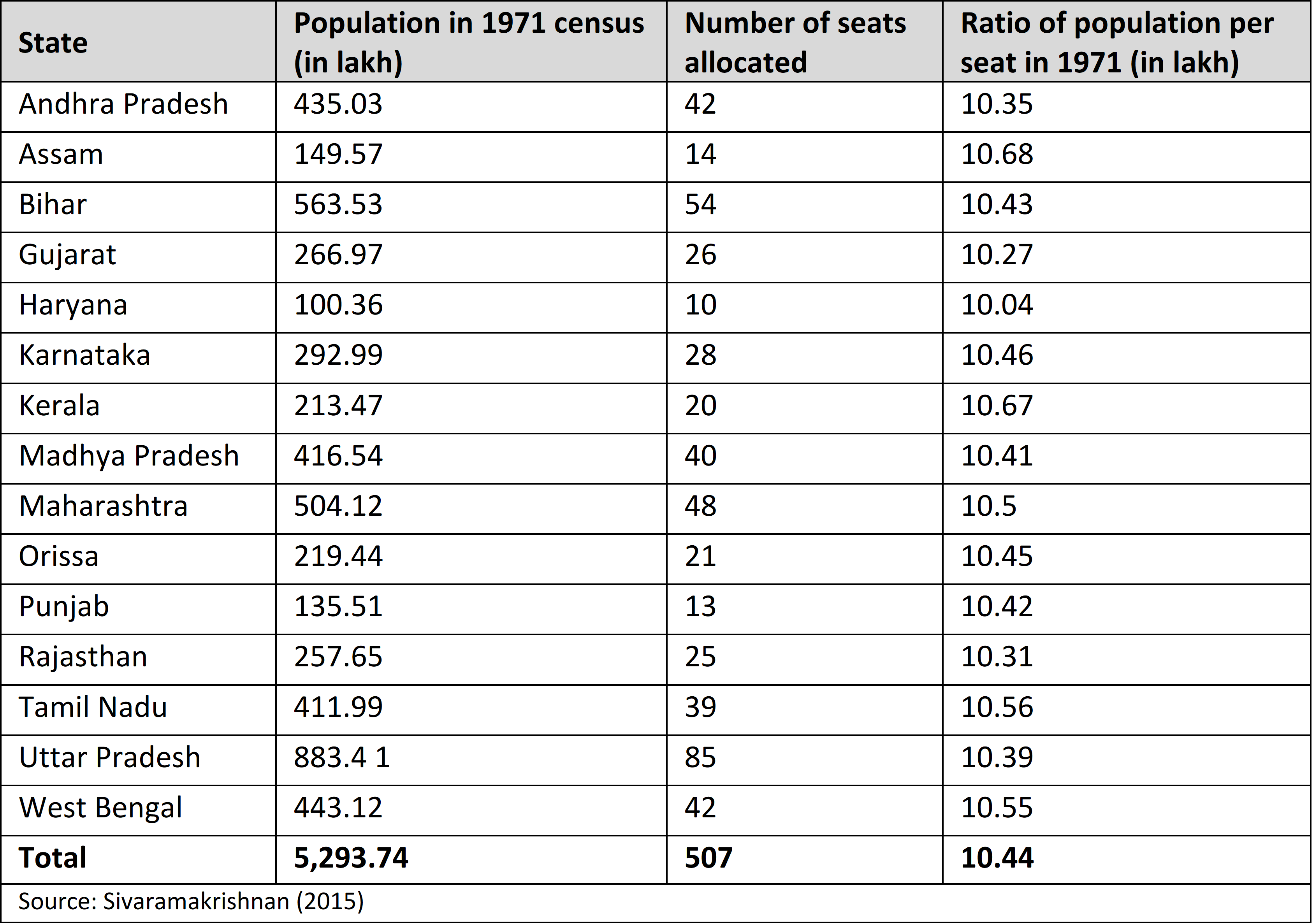
Table 2: People to Representative Ratio for Legislative Assemblies in the Third Delimitation (1972–76)
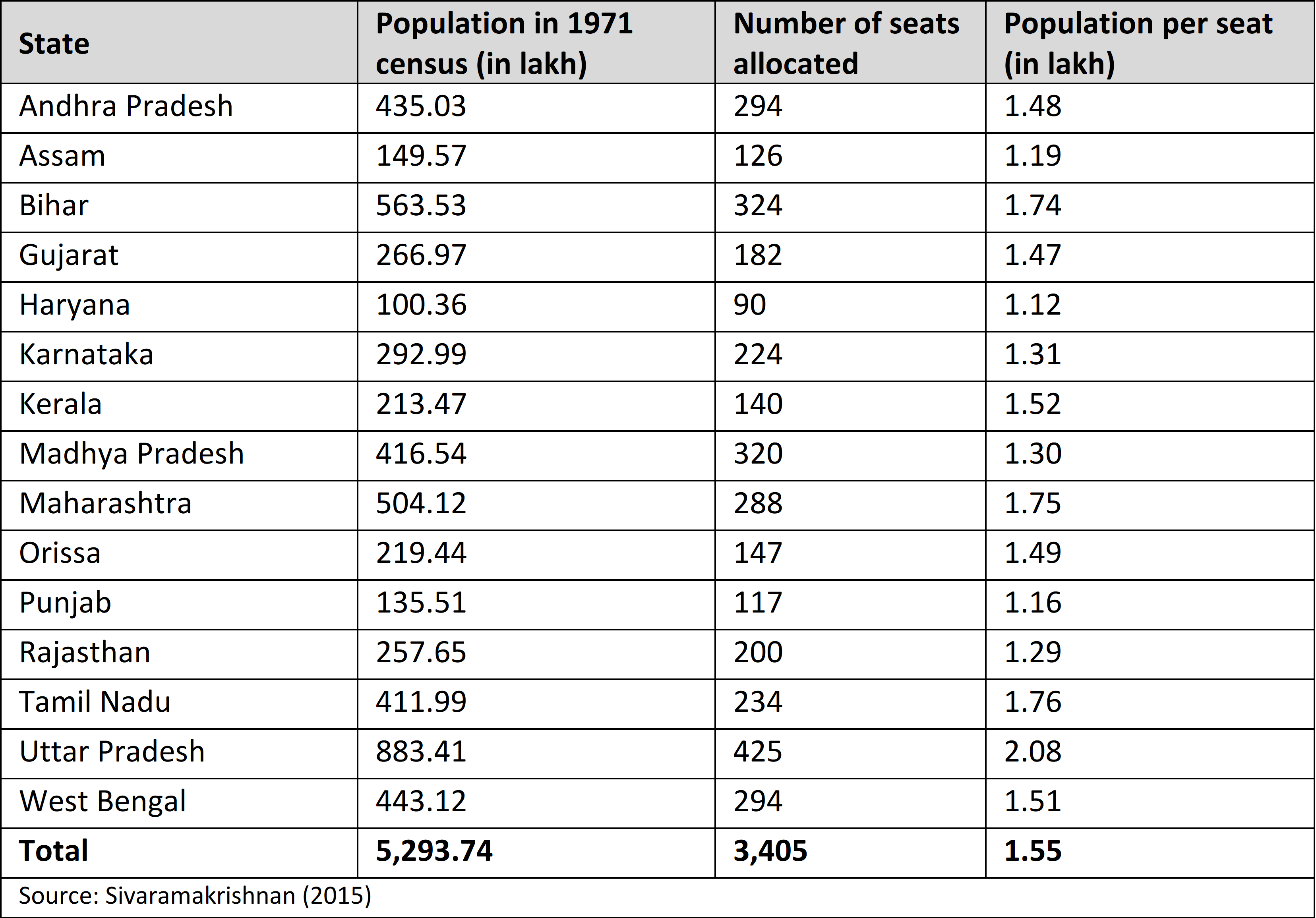
But the 10-year cycle of delimitation was brought to a halt by the 42nd Constitution Amendment Act, 1976. By a proviso to Article 82 as well as Article 170 (2), the amendment froze the population figure to that of the 1971 census and deferred further delimitation as well as reallocation of seats amongst the states until 2000. 2This was mainly in response to apprehension expressed by the southern states, which felt that after successfully implementing family planning programmes their share in overall population would decline, leading to a loss of representation in the Lok Sabha. In 2002, the embargo on delimitation was lifted and the fourth delimitation commission was constituted. Yet, the fourth round of delimitation was partial at best as it did not deal with redistribution of seats amongst states. It merely readjusted electoral boundaries within states. Moreover, Parliament through the 91st Amendment Bill (2001) sought to defer the next delimitation exercise till 2026. 3Statement of Objects and Reasons appended to the Constitution (91st Amendment) Bill, 2000 which was enacted as the Constitution (84th Amendment) Act, 2002, stated: “Keeping in view the progress of family planning programmes in different parts of the country, the Government, as part of the National Population Policy strategy, recently decided to extend the current freeze on undertaking fresh delimitation up to the year 2026 as a motivational measure to enable the State Governments to pursue the agenda for population stabilisation.”
Issues and implications
The suspension of delimitation for a long period of time has led to two negative consequences. First, it has created huge population disparities amongst constituencies within and across states. Broadly speaking, there have been two axes of population disparities. At one level, the urban constituencies have grown very large compared to rural ones because of increasing spatial mobility (from rural to urban areas). At another level, the northern states have seen a higher rate of population growth than the southern ones because of their failure to implement family planning programmes.
Compared with the third round of delimitation (1976), the people to representative ratio for the Lok Sabha almost doubled (18.9 lakh) by the time the fourth round took place in 2002.
As a result, the constituencies in the northern states have become more populous over time. For example, a Lok Sabha constituency in Rajasthan (based on 2001 census figures), on average, had more than 22 lakh people against 15.9 lakh people in Kerala (Table 3). In other words, a Lok Sabha constituency in Rajasthan had 1.5 times the population that it did in Kerala. By the next delimitation (if it is held a little before or after the 2031 census), the inter-state disparity in the size of Lok Sabha constituencies will have grown even bigger because the demographic gap between states/regions is shrinking at a slower pace.
A second consequence has been the ballooning population of constituencies across states. Compared with the third round of delimitation (1976), the people to representative ratio for the Lok Sabha almost doubled (18.9 lakh) by the time the fourth round took place. Compare this with the population represented by a member of parliament (MP) in the UK (92,000); Canada (1 lakh); Australia (1.7 lakh); and the US (7.4 lakh). By 2031, the average size of a Lok Sabha constituency will rise to 27 lakh (Table 3).
Interesting regional patterns cannot be missed. By 2031, while an MP in Kerala and Tamil Nadu will be representing a population of 18 to 20 lakh, his/her counterpart in Bihar, Madhya Pradesh, Rajasthan, and Uttar Pradesh will be representing more than 30 lakh people. This puts a big question mark on political representatives’ ability to effectively serve their constituencies because that they do not merely participate in law making but are also expected to serve their electors on the ground. Of late, what is termed as “constituency service” has grown in volume, content, and complexity. It covers a huge range of activities, including support to individuals, educating voters, chasing grievances, and carrying out development work.
Table 3: Changing Size of Lok Sabha Constituencies in Major States
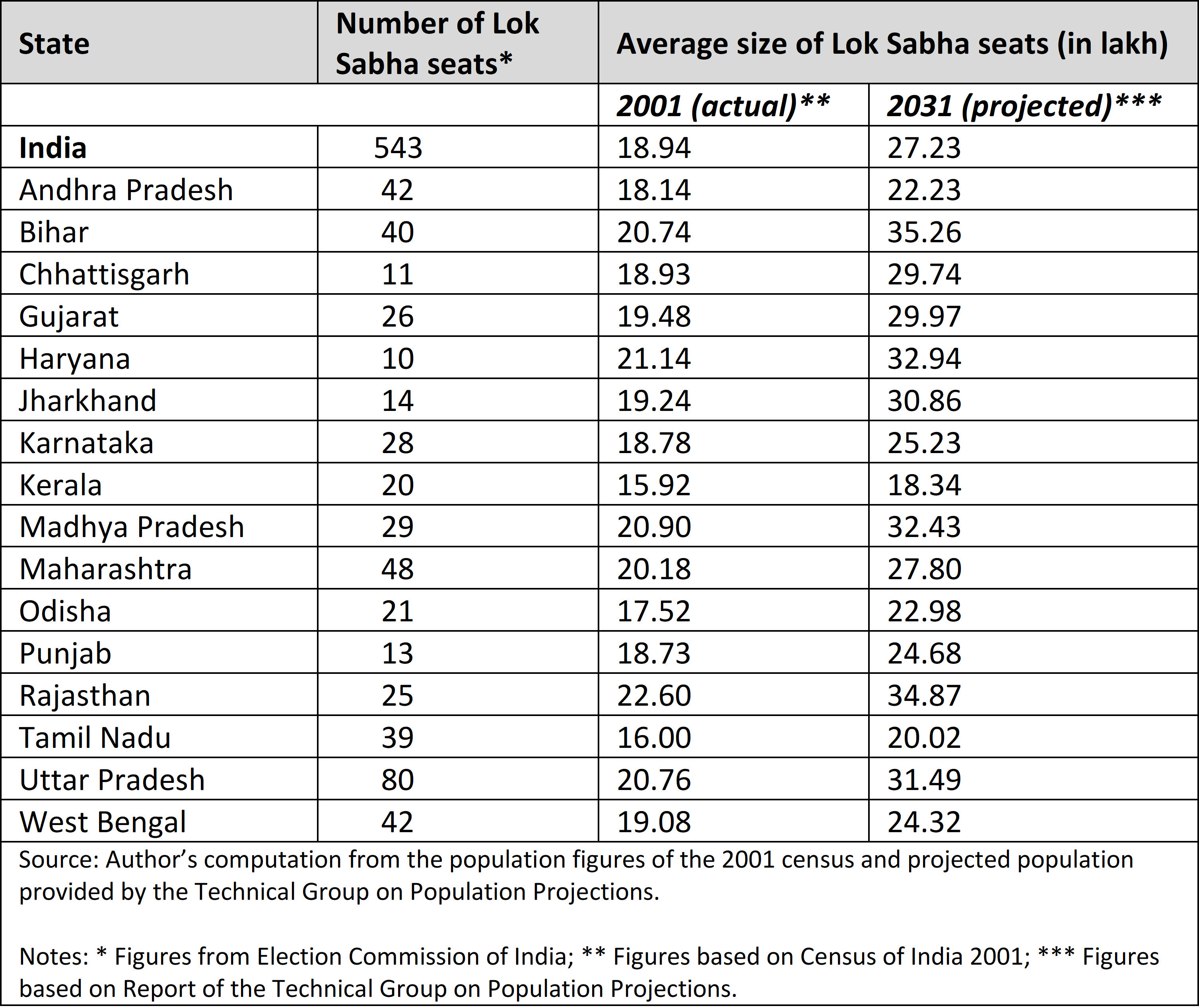
Bottlenecks
The redistribution of Lok Sabha seats amongst states has been a politically sensitive and contentious issue. At the centre of the problem is the unabated regional imbalance in population growth. It takes little to measure the effect of redistribution on the existing regional balance of power in Parliament. If allocation of Lok Sabha seats is done afresh on the basis of the population figures of the next census (assuming that it will be completed before or by 2026, the year that marks an end to the moratorium on delimitation) by keeping the current strength of the Lok Sabha unchanged, the contours of political representation will change drastically.
Taken together, the five southern states will lose as many as 24 seats, a loss of nearly one-fifth of the total number of seats they now have. Kerala is at the risk of losing about one third of the Lok Sabha seats it has. On the other hand, four Hindi heartland states together – UP, Bihar, Rajasthan, and MP – will add a whopping 34 seats to their kitty (Table 4).
Table 4: Proportional Allocation of Seats for Major States on the Basis of Projected Population in 2026
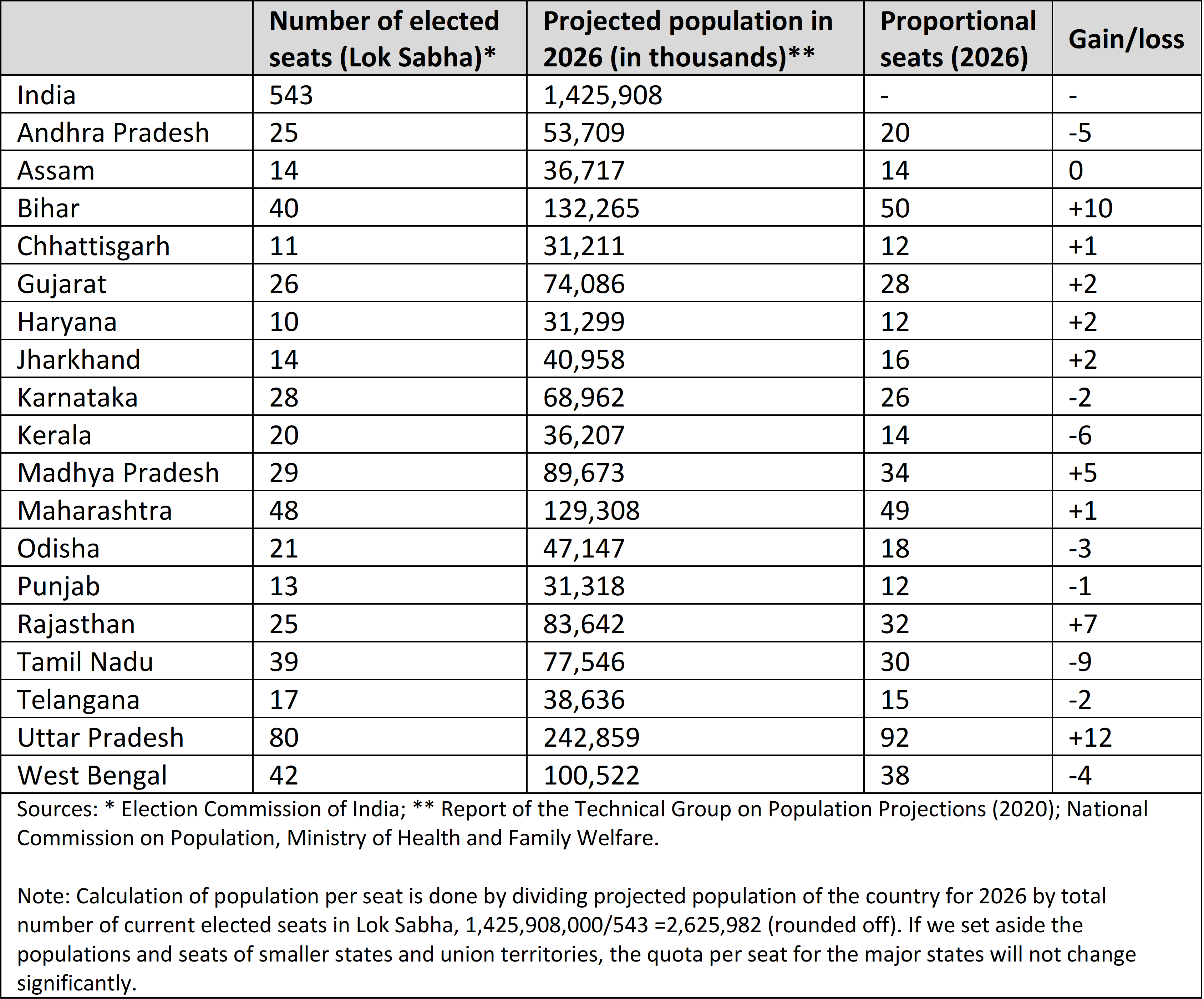
Sensing that the regional balance of power will further tilt towards the north, the political class of the southern states has been up in arms over the redistribution of Lok Sabha seats based on a proportional share of the population. Note that the southern states are separated from the northern ones not just demographically but also culturally and economically.
The argument therefore is that the redistribution of seats based on a state’s share in the country’s overall population would amount to penalising those states that have not only curbed population growth but also risen to become greater sources of the country’s revenue. A powerful argument though it may seem, the problem of inter-state disparities in political representation has reached a point where the reapportionment of seats cannot be delayed further.
Quest for a solution
A spectrum of possible solutions exists to end the reapportionment deadlock. At one extreme is the position privileging the “equal population” criterion. That is, let the states get as many seats as their population share warrants. This position is not only in line with what the Constitution provides for but also consistent with the idea of fair representation: one vote-one value. But it has little regard for the legitimate concerns of those states that are likely to lose some representation. Put differently, it has nothing to offer to deal with the real issue.
The position at the other extreme emphasises maintaining the status quo till the population growth rate across states is more or less the same. This is the position favoured by the southern states. The argument has some substance. For one, the principle of equal population does not apply to smaller states and union territories. They are overrepresented. For these states, considerations of federalism override the norm of one person-one vote-one value. If this is acceptable for one set of states, why not for others?
For another, there are many democracies (the UK and Canada) where redistribution of seats amongst federal units/regions is not done strictly on the basis of the proportional share of population. In other words, the ideal of one vote-one value is not so paramount as to be met at any cost. However, this position has three problems which, in turn, make it untenable.
One, it allows the problem to linger rather than solve it. Second, it treats the doctrine of fair representation as subservient to the interests of federal units. Third, it is blind to the constitutional amendments required for postponing delimitation time and again. Quite clearly, none of these sit pretty with the constitutional logic of political representation.
Between the two extremes lie a number of propositions. A middle-of-the road proposition is to expand the size of Lok Sabha to the extent that no state loses seats it now holds (McMillan 2008). Additional seats may be redistributed to states on the basis of their respective share in the country’s population.
On the face of it, the proposal sounds good for two reasons. First, an increase in Lok Sabha seats will reduce exceptionally large people to representative ratios. Second, the political clamour could be less vociferous if over-represented states do not lose representation.
But this proposal only partly helps resolve the issue at hand. For example, an increase in the number of Lok Sabha seats may save many states from losing seats but it fails to address the core issue of the power asymmetry that will result from the redistribution of seats. Therefore, it is doubtful if the southern states will be pacified by merely retaining the existing number of seats.
If the central concern is about protecting states’ interest, equalising the number of Rajya Sabha seats across states would greatly compensate for the loss of representation in the halls of power through redistributing Lok Sabha seats.
A second proposal is to shift the focus to the Upper House: the Rajya Sabha. That is, let the distribution of Lok Sabha seats across states be in accordance with their proportional share in the population but restructure the Rajya Sabha in such a way that it compensates for the loss of representation in the Lok Sabha.
There could be two ways of doing it. One is to devise a suitable schema of weightage (combining demographic and non-demographic attributes) so that that the group of losing states are advantaged. It is, nonetheless, a complicated exercise. The other way is to equalise the number of Rajya Sabha seats across states as is the practice in many federal countries such as the US, Nigeria, and South Africa, to name a few.
Technically speaking, the Rajya Sabha is the chamber representing states. If the central concern is about protecting states’ interest, equalising the number of Rajya Sabha seats across states would greatly compensate for the loss of representation in the halls of power through redistributing Lok Sabha seats. On the face of it, this proposal looks politically less contentious. Yet it is not an easy solution. It requires drastic institutional restructuring, involving amendments to the Constitution.
A third but a little more complicated variety of the middle-of-the road option is to combine the two proposals. That is, expand the size of the Lok Sabha to ensure that reallocating seats on the basis of a proportional share of population does not take away any seat from any state, and redistribute the Rajya Sabha seats to states by adopting new criteria.
Of course, restructuring the Rajya Sabha will require constitutional amendments but it will be a one-off exercise in contrast to deferring delimitation, which forces amending the Constitution time and again. This politically least cost model has helped many federal democracies manage regional claims of political representation, and it has worked pretty well for them.

